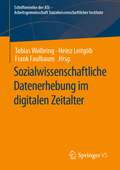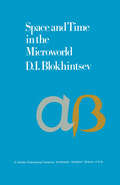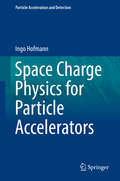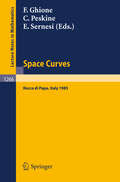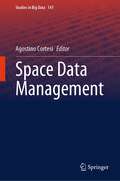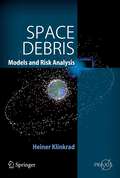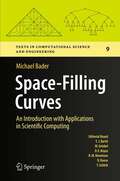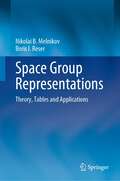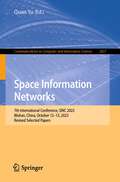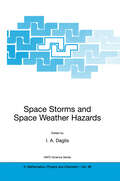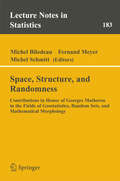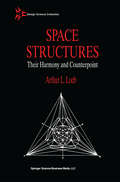- Table View
- List View
Sozialmedizinische Ansätze der Evaluation im Gesundheitswesen: Band 2: Qualitätssicherung in der ambulanten Versorgung und medizinische Rehabilitation
by Ferdinand Schliehe Ralph Brennecke Hartmut Weber-FalkensammerSozialräumliche Perspektiven in der stationären Altenhilfe: Eine empirische Studie im städtischen Raum
by Christian Bleck Anne Van Rießen Reinhold Knopp Thorsten SchleeSozialraumorientierte Handlungsansätze gewinnen auch in der Altenarbeit zunehmend an Bedeutung. Die vorliegende Studie hat mit qualitativen und quantitativen Forschungszugängen derzeitige Bezüge zwischen stationären Altenpflegeeinrichtungen und dem Sozialraum in der Stadt Düsseldorf untersucht. Exemplarisch für den städtischen Raum werden damit erstmals Deutungen, Voraussetzungen und Potentiale von Sozialraumorientierung in der Altenhilfe empirisch beleuchtet. Auf dieser Grundlage werden konkrete Handlungsbausteine für eine sozialraumsensible Altenarbeit in stationären Kontexten vorgeschlagen.Der InhaltSozialraumorientierung und Altenhilfe: Politische Programmatiken, konzeptionelle Ansätze und Stand der Sozialraumforschung • Theoretische Zugänge zu Sozialraum(orientierung) • Forschungsdesign • Darstellung der Ergebnisse • Resümee: Handlungsbausteine der Sozialraumorientierung in der stationären Altenhilfe Die AutorenDr. Christian Bleck ist Professor für die Wissenschaft Soziale Arbeit an der Hochschule Düsseldorf.Dr. Anne van Rießen ist Gastprofessorin für Soziale Arbeit und ihre Adressat_innen und (Nicht-) Nutzer_innen an der Hochschule Düsseldorf.Dr. Reinhold Knopp ist Professor für Stadtsoziologie an der Hochschule Düsseldorf.Dr. Thorsten Schlee ist wissenschaftlicher Mitarbeiter am Institut Arbeit und Qualifikation der Universität Duisburg-Essen.
Sozialwissenschaftliche Datenerhebung im digitalen Zeitalter (Schriftenreihe der ASI - Arbeitsgemeinschaft Sozialwissenschaftlicher Institute)
Neue Möglichkeiten der Datenerhebung mittels digitaler Technologien, aber auch die Verfügbarkeit prozessproduzierter Daten, die bei der Nutzung sozialer Medien, Smartphones oder sogenannter Wearables anfallen, bergen ein enormes Potenzial für die empirische Sozialforschung. Es erscheint vor diesem Hintergrund nicht übertrieben von einer digitalen Revolution in den Sozialwissenschaften zu sprechen, welche die empirische Sozialforschung mit neuen Herausforderungen und Fragestellungen konfrontiert. Der vorliegende Sammelband widmet sich diesem Themenkomplex mit überblicksartigen Beiträgen, Untersuchungen zur Datenqualität und praxisnahen Anwendungsbeispielen.
Soziologie: Sprache Bezug zur Praxis Verhältnis zu anderen Wissenschaften René König zum 65. Geburtstag
by Günter Albrecht René KönigSoziologische Erkenntnis und Geschichte: Über Möglichkeit und Grenzen einer empirisch-analytischen Orientierung in den Humanwissenschaften
by Reinhard KreckelSpace and Astrophysical Plasma Simulation: Methods, Algorithms, and Applications
by Jörg BüchnerThis book is a collection of contributions covering the major subjects in numerical simulation of space and astrophysical plasma. It introduces the different approaches and methods to model plasma, the necessary computational codes, and applications in the field. The book is rooted in the previous work Space Plasma Simulation (Springer, 2003) and includes the latest developments. It is divided into three parts and all chapters start with an introduction motivating the topic and its use in research and ends with a discussion of its applications. The chapters of the first part contain tutorials of the different basic approaches needed to perform space plasma simulations. This part is particularly useful for graduate students to master the subject. The second part presents more advanced materials for students and researchers who already work with pre-existing codes but want to implement the recent progresses made in the field. The last part of the book discusses developments in the area for researchers who are actively working on advanced simulation approaches like higher order schemes and artificial intelligence, agent-based technologies for multiscale and multi-dimensional systems, which represent the recent innovative contributions made in space plasma research.
Space Charge Physics for Particle Accelerators (Particle Acceleration and Detection)
by Ingo HofmannUnderstanding and controlling the physics of space charge effects in linear and circular proton and ion accelerators are essential to their operation, and to future high-intensity facilities. This book presents the status quo of this field from a theoretical perspective, compares analytical approaches with multi-particle computer simulations and – where available – with experiments. It discusses fundamental concepts of phase space motion, matched beams and modes of perturbation, along with mathematical models of analysis – from envelope to Vlasov-Poisson equations. The main emphasis is on providing a systematic description of incoherent and coherent resonance phenomena; parametric instabilities and sum modes; mismatch and halo; error driven resonances; and emittance exchange due to anisotropy, as well as the role of Landau damping. Their distinctive features are elaborated in the context of numerous sample simulations, and their potential impacts on beam quality degradation and beam loss are discussed. The book is intended for advanced beginners in accelerator research, and for experts interested in the mechanisms of direct space charge interaction and their modeling.
Space Curves: Proceedings of a Conference held in Rocca di Papa, Italy, June 3-8, 1985 (Lecture Notes in Mathematics #1266)
by Franco Ghione Christian Peskine Edoardo SernesiThe main topics of the conference on "Curves in Projective Space" were good and bad families of projective curves, postulation of projective space curves and classical problems in enumerative geometry.
Space Data Management (Studies in Big Data #141)
by Agostino CortesiThe book presents latest results pertaining to challenges faced by researchers in space data management. There are large number of highly important applications that currently rely upon data from satellites and space missions, ranging from weather prediction to monitoring of environmental pollution, climate change, marine traffic, agriculture, and urban planning, etc. The quality and quantity of space data poses new and specific challenges to the scientific community, covering the entire life cycle of space data management and with a need for an interdisciplinary approach. The chapters written by experts discusses impacts of these challenges, and report activities that can stimulate new research.
Space Debris: Models and Risk Analysis (Springer Praxis Books)
by Heiner KlinkradThe future evolution of the debris environment will be forecast on the basis of traffic models and possible hazard mitigation practices. The text shows how large trackable objects will have re-entry pinpointed and predictions made on related risk assessment for possible ground impact. Models will also be described for meteoroids which are also a prevailing risk.
Space Engineering: Modeling and Optimization with Case Studies (Springer Optimization and Its Applications #114)
by Giorgio Fasano János D. PintérThis book presents a selection of advanced case studies that cover a substantial range of issues and real-world challenges and applications in space engineering. Vital mathematical modeling, optimization methodologies and numerical solution aspects of each application case study are presented in detail, with discussions of a range of advanced model development and solution techniques and tools.Space engineering challenges are discussed in the following contexts: •Advanced Space Vehicle Design•Computation of Optimal Low Thrust Transfers•Indirect Optimization of Spacecraft Trajectories•Resource-Constrained Scheduling,•Packing Problems in Space•Design of Complex Interplanetary Trajectories•Satellite Constellation Image Acquisition•Re-entry Test Vehicle Configuration Selection•Collision Risk Assessment on Perturbed Orbits•Optimal Robust Design of Hybrid Rocket Engines•Nonlinear Regression Analysis in Space Engineering•Regression-Based Sensitivity Analysis and Robust Design•Low-Thrust Multi-Revolution Orbit Transfers•Modeling and Optimization of Balance Layout Problems•Pilot-Induced Oscillations Alleviation•Modeling and Optimization of Hybrid Transfers to Near-Earth Objects•Probabilistic Safety Analysis of the Collision Between Space Debris and Satellite•Flatness-based Low-thrust Trajectory Optimization for Spacecraft Proximity Operations The contributing authors are expert researchers and practitioners in either the space engineering and/or in the applied optimization fields. Researchers and practitioners working in various applied aspects of space engineering will find this book practical and informative. Academics, graduate and post-graduate students in aerospace engineering, applied mathematics, operations research, optimization, and optimal control, will find this book useful.
Space-Filling Curves: An Introduction with Applications in Scientific Computing (Texts in Computational Science and Engineering #9)
by Michael BaderThe present book provides an introduction to using space-filling curves (SFC) as tools in scientific computing. Special focus is laid on the representation of SFC and on resulting algorithms. For example, grammar-based techniques are introduced for traversals of Cartesian and octree-type meshes, and arithmetisation of SFC is explained to compute SFC mappings and indexings.The locality properties of SFC are discussed in detail, together with their importance for algorithms. Templates for parallelisation and cache-efficient algorithms are presented to reflect the most important applications of SFC in scientific computing. Special attention is also given to the interplay of adaptive mesh refinement and SFC, including the structured refinement of triangular and tetrahedral grids. For each topic, a short overview is given on the most important publications and recent research activities.
Space-Filling Curves (Universitext)
by Hans SaganThe subject of space-filling curves has fascinated mathematicians for over a century and has intrigued many generations of students of mathematics. Working in this area is like skating on the edge of reason. Unfortunately, no comprehensive treatment has ever been attempted other than the gallant effort by W. Sierpiriski in 1912. At that time, the subject was still in its infancy and the most interesting and perplexing results were still to come. Besides, Sierpiriski's paper was written in Polish and published in a journal that is not readily accessible (Sierpiriski [2]). Most of the early literature on the subject is in French, German, and Polish, providing an additional raison d'etre for a comprehensive treatment in English. While there was, understandably, some intensive research activity on this subject around the turn of the century, contributions have, nevertheless, continued up to the present and there is no end in sight, indicating that the subject is still very much alive. The recent interest in fractals has refocused interest on space filling curves, and the study of fractals has thrown some new light on this small but venerable part of mathematics. This monograph is neither a textbook nor an encyclopedic treatment of the subject nor a historical account, but it is a little of each. While it may lend structure to a seminar or pro-seminar, or be useful as a supplement in a course on topology or mathematical analysis, it is primarily intended for self-study by the aficionados of classical analysis.
Space Group Representations: Theory, Tables and Applications
by Nikolai B. Melnikov Boris I. ReserThis book is devoted to the construction of space group representations, their tabulation, and illustration of their use. Representation theory of space groups has a wide range of applications in modern physics and chemistry, including studies of electron and phonon spectra, structural and magnetic phase transitions, spectroscopy, neutron scattering, and superconductivity. The book presents a clear and practical method of deducing the matrices of all irreducible representations, including double-valued, and tabulates the matrices of irreducible projective representations for all 32 crystallographic point groups. One obtains the irreducible representations of all 230 space groups by multiplying the matrices presented in these compact and convenient to use tables by easily computed factors. A number of applications to the electronic band structure calculations are illustrated through real-life examples of different crystal structures. The book's content is accessible to both graduate and advanced undergraduate students with elementary knowledge of group theory and is useful to a wide range of experimentalists and theorists in materials and solid-state physics.
Space Information Networks: 7th International Conference, SINC 2023, Wuhan, China, October 12–13, 2023, Revised Selected Papers (Communications in Computer and Information Science #2057)
by Quan YuThis book constitutes revised selected papers from the thoroughly refereed proceedings of the 7th International Conference on Space Information Network, SINC 2023, held in Wuhan, China, during October 12–13, 2023. The 8 full papers and 5 short papers included in this book were carefully reviewed and selected from 73 submissions. The papers present the latest research in the fields of space information networks.
Space, Number, and Geometry from Helmholtz to Cassirer (Archimedes #46)
by Francesca BiagioliThis book offers a reconstruction of the debate on non-Euclidean geometry in neo-Kantianism between the second half of the nineteenth century and the first decades of the twentieth century. Kant famously characterized space and time as a priori forms of intuitions, which lie at the foundation of mathematical knowledge. The success of his philosophical account of space was due not least to the fact that Euclidean geometry was widely considered to be a model of certainty at his time. However, such later scientific developments as non-Euclidean geometries and Einstein’s general theory of relativity called into question the certainty of Euclidean geometry and posed the problem of reconsidering space as an open question for empirical research. The transformation of the concept of space from a source of knowledge to an object of research can be traced back to a tradition, which includes such mathematicians as Carl Friedrich Gauss, Bernhard Riemann, Richard Dedekind, Felix Klein, and Henri Poincaré, and which finds one of its clearest expressions in Hermann von Helmholtz’s epistemological works. Although Helmholtz formulated compelling objections to Kant, the author reconsiders different strategies for a philosophical account of the same transformation from a neo-Kantian perspective, and especially Hermann Cohen’s account of the aprioricity of mathematics in terms of applicability and Ernst Cassirer’s reformulation of the a priori of space in terms of a system of hypotheses. This book is ideal for students, scholars and researchers who wish to broaden their knowledge of non-Euclidean geometry or neo-Kantianism.
The Space of Dynamical Systems with the C0-Topology (Lecture Notes in Mathematics #1571)
by Sergei Yu. PilyuginThis book is an introduction to main methods and principal results in the theory of Co(remark: o is upper index!!)-small perturbations of dynamical systems. It is the first comprehensive treatment of this topic. In particular, Co(upper index!)-generic properties of dynamical systems, topological stability, perturbations of attractors, limit sets of domains are discussed. The book contains some new results (Lipschitz shadowing of pseudotrajectories in structurally stable diffeomorphisms for instance). The aim of the author was to simplify and to "visualize" some basic proofs, so the main part of the book is accessible to graduate students in pure and applied mathematics. The book will also be a basic reference for researchers in various fields of dynamical systems and their applications, especially for those who study attractors or pseudotrajectories generated by numerical methods.
Space Plasma Simulation (Lecture Notes in Physics #615)
by Jörg Büchner Christian Dum Manfred ScholerThe aim of this book is twofold: to provide an introduction for newcomers to state of the art computer simulation techniques in space plasma physics and an overview of current developments. Computer simulation has reached a stage where it can be a highly useful tool for guiding theory and for making predictions of space plasma phenomena, ranging from microscopic to global scales. The various articles are arranged, as much as possible, according to the - derlying simulation technique, starting with the technique that makes the least number of assumptions: a fully kinetic approach which solves the coupled set of Maxwell’s equations for the electromagnetic ?eld and the equations of motion for a very large number of charged particles (electrons and ions) in this ?eld. Clearly, this is also the computationally most demanding model. Therefore, even with present day high performance computers, it is the most restrictive in terms of the space and time domain and the range of particle parameters that can be covered by the simulation experiments. It still makes sense, therefore, to also use models, which due to their simp- fying assumptions, seem less realistic, although the e?ect of these assumptions on the outcome of the simulation experiments needs to be carefully assessed.
Space Storms and Space Weather Hazards (NATO Science Series II: Mathematics, Physics and Chemistry #38)
by I. A. DaglisSpace storms, the manifestation of bad weather in space, have a number of physical effects in the near-Earth environment: acceleration of charged particles in space, intensification of electric currents in space and on the ground, impressive aurora displays, and global magnetic disturbances on the Earth's surface. Space weather has been defined as `conditions on the Sun and in the solar wind, magnetosphere, ionosphere, and atmosphere that can influence the performance and reliability of space- and ground-based technological systems and can endanger human life'. The 19 chapters of this book, written by some of the foremost experts on the topic, present the most recent developments in space storm physics and related technological issues, such as malfunction of satellites, communication and navigation systems, and electric power distribution grids.Readership: researchers, teachers and graduate students in space physics, astronomy, geomagnetism, space technology, electric power and communication technology, and non-specialist physicists and engineers. As recommended in the United Nations Space & Atmospheric Science Education Curriculum booklet. Please find it amongst classics such as T.J.M. Boyd, J.J. Sanderson, J.K. Hargreaves and M.C. Kelly etc.
Space Strategy
by Jean-Luc LefebvreStrategy is the art of thinking about war before it occurs. Noting that space already plays a role in all of today’s wars, Space Strategy studies how conflicts are extending into this new domain. The book defines extra-atmospheric space and focuses on its varying features and constraints. By exploring the opportunities for action provided by different strategic positions, the book analyzes the most plausible combat scenarios from, against and within space. It explains the concepts of militarization, weaponization and martialization of space and shows how space systems constitute an essential component of information literacy – the key to power in the 21st Century. Space Strategy then demonstrates why our society, having become space-dependent, must take appropriate measures to develop its spatioresilience. Finally, the author summarizes his reflections in the form of a mnemonic listing twelve principles of space strategy. Completed by educational appendices and a glossary containing one thousand entries, Space Strategy meets the needs of students, researchers or any other reader curious about expanding their knowledge of strategy.
Space Strategy
by Jean-Luc LefebvreStrategy is the art of thinking about war before it occurs. Noting that space already plays a role in all of today’s wars, Space Strategy studies how conflicts are extending into this new domain. The book defines extra-atmospheric space and focuses on its varying features and constraints. By exploring the opportunities for action provided by different strategic positions, the book analyzes the most plausible combat scenarios from, against and within space. It explains the concepts of militarization, weaponization and martialization of space and shows how space systems constitute an essential component of information literacy – the key to power in the 21st Century. Space Strategy then demonstrates why our society, having become space-dependent, must take appropriate measures to develop its spatioresilience. Finally, the author summarizes his reflections in the form of a mnemonic listing twelve principles of space strategy. Completed by educational appendices and a glossary containing one thousand entries, Space Strategy meets the needs of students, researchers or any other reader curious about expanding their knowledge of strategy.
Space, Structure and Randomness: Contributions in Honor of Georges Matheron in the Fields of Geostatistics, Random Sets and Mathematical Morphology (Lecture Notes in Statistics #183)
by Michel Bilodeau Fernand Meyer Michel SchmittSpace, structure, and randomness: these are the three key concepts underlying Georges Matheron’s scientific work. He first encountered them at the beginning of his career when working as a mining engineer, and then they resurfaced in fields ranging from meteorology to microscopy. What could these radically different types of applications possibly have in common? First, in each one only a single realisation of the phenomenon is available for study, but its features repeat themselves in space; second, the sampling pattern is rarely regular, and finally there are problems of change of scale. This volume is divided in three sections on random sets, geostatistics and mathematical morphology. They reflect his professional interests and his search for underlying unity. Some readers may be surprised to find theoretical chapters mixed with applied ones. We have done this deliberately. GM always considered that the distinction between the theory and practice was purely academic. When GM tackled practical problems, he used his skill as a physicist to extract the salient features and to select variables which could be measured meaningfully and whose values could be estimated from the available data. Then he used his outstanding ability as a mathematician to solve the problems neatly and efficiently. It was his capacity to combine a physicist’s intuition with a mathematician’s analytical skills that allowed him to produce new and innovative solutions to difficult problems. The book should appeal to graduate students and researchers working in mathematics, probability, statistics, physics, spatial data analysis, and image analysis. In addition it will be of interest to those who enjoy discovering links between scientific disciplines that seem unrelated at first glance. In writing the book the contributors have tried to put GM’s ideas into perspective. During his working life, GM was a genuinely creative scientist. He developed innovative concepts whose usefulness goes far beyond the confines of the discipline for which they were originally designed. This is why his work remains as pertinent today as it was when it was first written.
Space Structures (Design Science Collection)
by A. Loebxiv aggregates: this touches on the very nature of things. The concept of statistical symmetry which Loeb develops is particularly important, it emphasizes the limitations in seemingly random aggregates and for permits general statements of which the crystallographer's sym metries are only special cases. The reductionist and holistic approaches to the world have been at war with each other since the times of the Greek philosophers and before. In nature, parts clearly do fit together into real structures, and the parts are affected by their environment. The problem is one of understanding. The mystery that remains lies largely in the nature of structural hierarchy, for the human mind can examine nature on many different scales sequentially but not simultaneously. Arthur Loeb's monograph is a fundamental one, but one can sense a devel opment from the relations between his zero-and three-dimensional cells to the far more complex world of organisms and concepts. It is structure that makes the difference between a cornfield and a cake, between an aggregate of cells and a human being, between a random group of human beings and a society. We can perceive anything only when we perceive its structure, and we think by structural analogy and comparison. Several books have been published showing the beauty of form in nature. This one has the beauty of a work of art, but it grows out of rigorous mathematics and from the simplest of bases-dimensional ity, extent and valency.
Space-time: An Introduction to Einstein's Theory of Gravity
by Jonathan AlldayRead an exlusive interview with Dr. Allday where he discusses the importance of the monumental first image of the black hole, here. This book, suitable for interested post-16 school pupils or undergraduates looking for a supplement to their course text, develops our modern view of space-time and its implications in the theories of gravity and cosmology. While aspects of this topic are inevitably abstract, the book seeks to ground thinking in observational and experimental evidence where possible. In addition, some of Einstein’s philosophical thoughts are explored and contrasted with our modern views. Written in an accessible yet rigorous style, Jonathan Allday, a highly accomplished writer, brings his trademark clarity and engagement to these fascinating subjects, which underpin so much of modern physics. Features: Restricted use of advanced mathematics, making the book suitable for post-16 students and undergraduates Contains discussions of key modern developments in quantum gravity, and the latest developments in the field, including results from the Laser Interferometer Gravitational-Wave Observatory (LIGO) Accompanied by appendices on the CRC Press website featuring detailed mathematical arguments for key derivations


